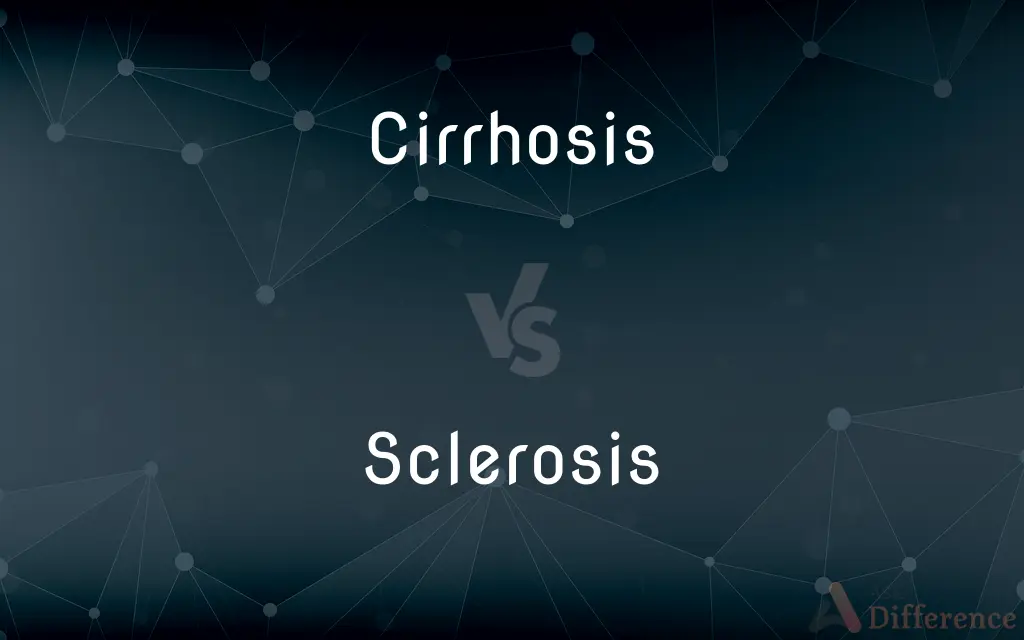Cirrhosis vs. Sclerosis — What's the Difference?
By Tayyaba Rehman & Urooj Arif — Updated on March 28, 2024
Cirrhosis is a chronic liver condition marked by scarring, while sclerosis refers to hardening of tissue or organs broadly.

Difference Between Cirrhosis and Sclerosis
Table of Contents
ADVERTISEMENT
Key Differences
Cirrhosis specifically targets the liver, leading to scarring and impaired liver function as a result of long-term damage from factors like alcohol abuse or hepatitis. On the other hand, sclerosis is a broader term that denotes the hardening or scarring of tissues in various parts of the body, which can occur due to a range of diseases, including multiple sclerosis (affecting the central nervous system) and systemic sclerosis (affecting the skin and other organs).
The progression of cirrhosis can lead to severe complications such as liver failure or cancer, underscoring the liver’s critical role in detoxification, metabolism, and blood regulation. Whereas, sclerosis, depending on its type and location, can lead to varying degrees of organ or tissue dysfunction, with symptoms and outcomes that widely differ, such as neurological impairment in multiple sclerosis.
Cirrhosis is often the result of chronic alcoholism, viral hepatitis (hepatitis B and C), and fatty liver disease, among other causes. In contrast, sclerosis can be caused by autoimmune reactions (as in multiple sclerosis), genetic factors, and chronic inflammation, showing the diversity in potential origins and mechanisms.
Treatment for cirrhosis focuses on slowing the progression of liver damage, managing symptoms, and addressing complications. For sclerosis, treatment is highly dependent on the specific condition (e.g., medications for multiple sclerosis to manage symptoms and slow disease progression).
The impact of cirrhosis is largely localized to liver function, affecting detoxification processes, blood clotting, and hormone regulation. Sclerosis can have more varied impacts depending on the affected area, such as impairing mobility in the case of multiple sclerosis, or affecting skin elasticity in systemic sclerosis.
ADVERTISEMENT
Comparison Chart
Definition
Chronic liver damage leading to scarring and dysfunction
Hardening or scarring of tissue or organs generally
Primary Causes
Alcohol abuse, viral hepatitis, fatty liver disease
Autoimmune diseases, genetic factors, inflammation
Key Symptoms
Jaundice, fatigue, weakness, easy bleeding
Varies widely; can include numbness, skin tightening
Treatment
Lifestyle changes, medications, possibly liver transplant
Depends on specific condition; often involves medication
Impact
Mainly liver function, potentially leading to liver failure
Varies by condition, can affect multiple body systems
Compare with Definitions
Cirrhosis
Liver scarring.
The patient's cirrhosis was a result of chronic alcohol abuse, leading to significant liver scarring.
Sclerosis
Caused by a variety of factors.
Her systemic sclerosis was thought to be autoimmune in origin.
Cirrhosis
Impaired liver function.
Cirrhosis caused her to have difficulties with blood clotting and increased susceptibility to infection.
Sclerosis
General tissue hardening.
Sclerosis can occur in various parts of the body, leading to tissue hardening and loss of function.
Cirrhosis
Result of long-term liver damage.
Years of battling hepatitis C culminated in cirrhosis for him.
Sclerosis
Can affect the central nervous system.
Multiple sclerosis is a type of sclerosis that affects the brain and spinal cord.
Cirrhosis
Managed with lifestyle changes.
He managed his cirrhosis with a strict diet and abstaining from alcohol.
Sclerosis
Symptoms vary widely.
Depending on the type, sclerosis symptoms can range from skin hardening to neurological impairment.
Cirrhosis
Can lead to liver failure.
Without intervention, cirrhosis can progress to liver failure, necessitating a transplant.
Sclerosis
Treatment depends on condition.
Treatment for his sclerosis involved managing symptoms and slowing the disease's progression.
Cirrhosis
Cirrhosis, also known as liver cirrhosis or hepatic cirrhosis, and end-stage liver disease, is the impaired liver function caused by the formation of scar tissue known as fibrosis, due to damage caused by liver disease. Damage causes tissue repair and subsequent formation of scar tissue, which over time can replace normal functioning tissue leading to the impaired liver function of cirrhosis.
Sclerosis
A thickening or hardening of a body part, as of an artery, especially from excessive formation of fibrous interstitial tissue.
Cirrhosis
Any of various chronic diseases of the liver characterized by the replacement of normal tissue with fibrous tissue and the loss of functional liver cells, resulting from a variety of causes that include chronic alcoholism and certain diseases and infections, especially hepatitis C.
Sclerosis
A disease characterized by this thickening or hardening.
Cirrhosis
Chronic interstitial inflammation of any tissue or organ. No longer in clinical use.
Sclerosis
(Botany) The hardening of cells by the formation of a secondary wall and the deposition of lignin.
Cirrhosis
(pathology) A chronic disease of the liver caused by damage from toxins (including alcohol), metabolic problems, hepatitis, or nutritional deprivation, characterised by an increase in fibrous tissue and the destruction of liver cells.
Sclerosis
(pathology) The abnormal hardening of body tissues, such as an artery; the appearance of hardenings, indurations, lesions, nodules.
Cirrhosis
(by extension) Interstitial inflammation of kidneys, lungs, and other organs.
Sclerosis
Inability to create change or excessive resistance to change.
Cirrhosis
A disease of the liver in which it usually becomes smaller in size and more dense and fibrous in consistence; hence sometimes applied to similar changes in other organs, caused by increase in the fibrous framework and decrease in the proper substance of the organ.
Sclerosis
Induration; hardening; especially, that form of induration produced in an organ by increase of its interstitial connective tissue.
Cirrhosis
A chronic disease interfering with the normal functioning of the liver; the major cause is chronic alcoholism
Sclerosis
Hardening of the cell wall by lignification.
Sclerosis
Any pathological hardening or thickening of tissue
Common Curiosities
Can sclerosis affect the brain?
Yes, multiple sclerosis affects the central nervous system, including the brain and spinal cord.
What are common causes of cirrhosis?
Common causes include chronic alcoholism, viral hepatitis (hepatitis B and C), and fatty liver disease.
Is cirrhosis reversible?
While early liver damage may be reversible, cirrhosis involves permanent scarring and damage.
What symptoms are associated with sclerosis?
Symptoms vary widely depending on the type of sclerosis, ranging from numbness to skin tightening.
How is cirrhosis treated?
Treatment includes lifestyle changes, medications, and in severe cases, liver transplantation.
How does sclerosis differ from cirrhosis?
Sclerosis refers to the hardening of tissue or organs broadly, while cirrhosis specifically describes liver scarring and dysfunction.
Can sclerosis lead to other health issues?
Yes, depending on the type, sclerosis can lead to complications like mobility issues, pain, and other organ dysfunction.
What role does genetics play in sclerosis and cirrhosis?
Genetics can influence susceptibility to both conditions, though environmental factors and lifestyle choices are significant in cirrhosis.
Are there preventive measures for cirrhosis?
Yes, avoiding alcohol, maintaining a healthy weight, and getting vaccinated against hepatitis B and C can help prevent cirrhosis.
What are the implications of sclerosis on daily life?
The impact can vary significantly, from minor inconvenience to major disability, depending on the sclerosis type and severity.
How are sclerosis and cirrhosis diagnosed?
Both conditions are diagnosed through a combination of medical history, physical examinations, and tests like imaging and biopsies.
What is cirrhosis?
Cirrhosis is a late stage of scarring (fibrosis) of the liver caused by many forms of liver diseases and conditions.
What research is being done on cirrhosis and sclerosis?
Research focuses on understanding the causes, developing better treatments, and finding potential cures for both conditions.
Is there a cure for sclerosis?
There is no cure for most types of sclerosis, but treatments are available to manage symptoms and slow progression.
Can lifestyle changes impact the progression of sclerosis?
While the impact varies by type, healthy lifestyle choices can help manage symptoms and improve quality of life.
Share Your Discovery

Previous Comparison
Greasy vs. Oily
Next Comparison
Caterer vs. ChefAuthor Spotlight
Written by
Tayyaba RehmanTayyaba Rehman is a distinguished writer, currently serving as a primary contributor to askdifference.com. As a researcher in semantics and etymology, Tayyaba's passion for the complexity of languages and their distinctions has found a perfect home on the platform. Tayyaba delves into the intricacies of language, distinguishing between commonly confused words and phrases, thereby providing clarity for readers worldwide.
Co-written by
Urooj ArifUrooj is a skilled content writer at Ask Difference, known for her exceptional ability to simplify complex topics into engaging and informative content. With a passion for research and a flair for clear, concise writing, she consistently delivers articles that resonate with our diverse audience.















































